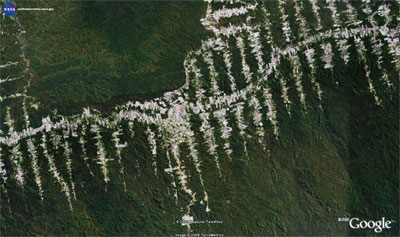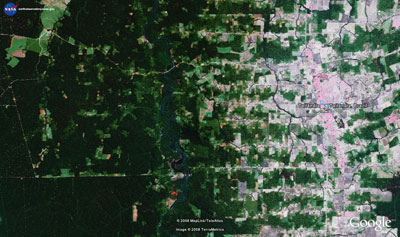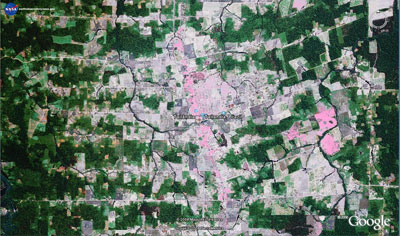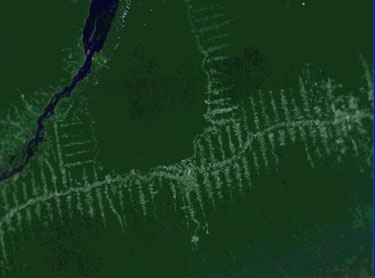Roads and Rainforests - of course they matter...
-----------------
Chainsaws, bulldozers, and fires are tools of rainforest destruction, but roads are enablers.
Roads link markets to resources, enabling loggers, farmers, ranchers, miners, and land speculators to convert remote forests into economic opportunities. But the ecological cost is high: 95 percent of deforestation in the Brazilian Amazon occurs within 50-kilometers of a road, while in Central Africa, where logging roads are rapidly expanding across the Congo basin, the bulk of bushmeat hunting occurs near roads. In Laos and Sumatra, roads are opening last remnants of intact forests to logging, poaching, and plantation development. But roads also cause subtler impacts, fragmenting habitats, altering microclimates, creating highways for invasive species, blocking movement of wildlife, and claiming animals as roadkill. A new paper, published in Trends in Evolution and Ecology, reviews these and other impacts of roads on rainforests. Its conclusions don't bode well for the future of forests.
|
|
| BR-230 highway near Rurópolis, Brazil in the heart of the Amazon. Image courtesy of Google Earth |
Examining a large body of scientific literature, William F. Laurance, Miriam Goosem and Susan G.W. Laurance write that roads "can have an array of deleterious effects on tropical forests and their wildlife" in the form of biological and socioeconomic impacts. The latter is a far greater threat to forests.
Over the past half century road networks have expanded across the tropics, opening remote forests to development. Once prompted primarily by political objectives such as national security, alleviating population pressures in cities, and rural development, roads are increasingly built by private interests — loggers, miners, and agribusiness — seeking access to resources and land. These "unofficial" roads complement existing government-sanctioned roads, amplifying their already substantial impact. Industry also exerts pressure on lawmakers to fund road improvement projects, like the paving of highways. These improvements further promote the expansion of unofficial road networks, which improve the economic viability of resource extraction and agricultural production in once inaccessible areas, attracting colonists and speculators, who cut and burn forests, hunt, and introduce alien species. Improved economic viability provides greater incentive for more road-building and the cycle continues.
Roads in the Amazon
The Brazilian Amazon is prime example of how roads have spurred large-scale change in the rainforest. Extensive deforestation began in the late 1960s when the Brazil's military government launched development programs to promote colonization in the region. The plan, which sought to provide economic opportunities for landless poor from crowded parts of the country and establish a national presence in the vast and sparsely populate interior, offered subsidized loans to settlers and ranchers, and funded ambitious highway projects like the Trans-Amazonian highway.
|
|
|
|
| Forest clearing and development near Tailândia, Brazil. Image courtesy of Google Earth |
While the Trans-Amazonian largely failed to meet its economic and social goals, it did open up large tracts of previously inaccessible rainforest land to development. Vast stretches of land were cleared for low-intensity cattle pasture and short-term subsistence agriculture. Despite laws restricting land-clearing to 50 percent of a settler's holdings, deforestation rates climbed from negligible to more than 20,000 square kilometers per year in the 1980s. Giant infrastructure projects—notably dams—facilitated development in the region, while logging spurred the growth of unofficial road networks and subsidized agricultural expansion that has helped turn Brazil into the world's largest exporter of many farm products. Its emergence as a global agricultural superpower has today created in Brazil a strong political block that lobbies for new infrastructure developments in the Amazon. With tens of billions of dollars now allocated to projects, including improvement of existing roads and construction of new highways, the future of the Amazon is increasingly linked to globalized markets, including demand for commodities.
But road impacts in the Amazon are not limited to Brazil. Peru is putting the finishing touches on the Carretera Transoceanica, a highway that will connect the heart of the Amazon to Pacific ports. The project, which is largely funded by China and Brazil, will create an export pipeline for timber, minerals, and agricultural products to the world's fasting-growing consumer. Oil, gas, and mining companies are already setting up shop in the area, sometimes in conflict with indigenous groups and protected areas. Meanwhile roads are also extending into key forest areas in Guyana, Colombia, Ecuador, Venezuela, and other parts of Peru.
|
|
| Roads in the Brazilian Amazon. Courtesy of Digital Earth. |
Outside of Latin America, major roads projects are planned or under construction in a number of tropical forests areas. Among others, the authors note the Trans-Congo Road in Democratic Republic of Congo, a 1600-km road that will cut southeast to northwest across the Congo Basin providing access to timber and minerals; the North–South Economic Corridor, a 1500-km highway across Laos, Cambodia, Thailand and Myanmar; the Leuser Road Plan, a network of more than 1600 km of major and minor roads in northern Sumatra; and the Mamberamo Basin Road which will run 1400 km through primary rainforests in northwestern New Guinea (Indonesia).
Limiting damage from roads
Aside from restricting development of new roads from frontier forest areas, there are limited options for mitigating the impacts of road expansion. Current efforts focus on measures taken in advance of road construction. For example, the Juma Sustainable Development Reserve Project for Reducing Greenhouse Gas Emissions from Deforestation aims to curb forest clearing along the AM-174 and BR-319 highways by establishing a network of strict protected areas along the roads. The project is financed by a forest carbon fund on the basis that it will reduce emissions from deforestation by 190 million tons of carbon dioxide by 2050 compared to a business-as-usual approach.
The authors also highlight other mechanisms for minimizing road impacts, including regulating access to roads, promoting railroads when possible, requiring proper environmental impact assessments prior to construction, limiting road width and gradient, restricting tree clearing along roads, and banning night-time driving. But in the end, the authors conclude that "actively limiting frontier roads... is by far the most realistic, cost-effective approach to promote the conservation of tropical nature and its crucial ecosystem services."
William F. Laurance, Miriam Goosem and Susan G.W. Laurance. Impacts of roads and linear clearings on tropical forests. Trends in Evolution and Ecology (TREE) 1149 1–11
Copyright:Issued by: Mongaby
Author: Rhett Butler
e-Mail:
Issue date: September 24, 2009
Link to Article: Origin of text
---------------





